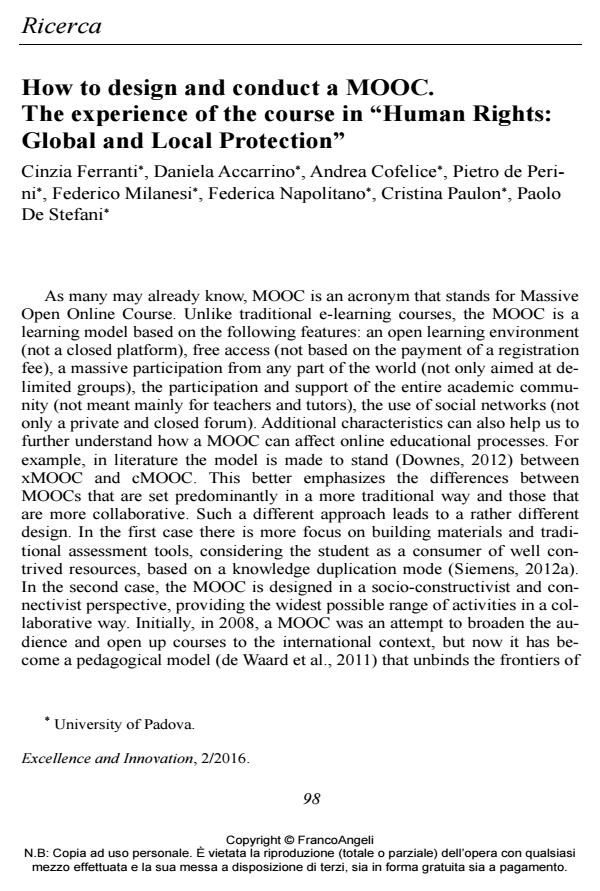How to design and conduct a MOOC. The experience of the course in "Human Rights: Global and Local Protection"
Titolo Rivista EXCELLENCE AND INNOVATION IN LEARNING AND TEACHING
Autori/Curatori Cinzia Ferranti, Daniela Accarrino, Andrea Cofelice, Pietro de Perini, Federico Milanesi, Federica Napolitano, Cristina Paulon, Paolo De Stefani
Anno di pubblicazione 2016 Fascicolo 2016/2
Lingua Inglese Numero pagine 17 P. 98-114 Dimensione file 238 KB
DOI 10.3280/EXI2016-002007
Il DOI è il codice a barre della proprietà intellettuale: per saperne di più
clicca qui
Qui sotto puoi vedere in anteprima la prima pagina di questo articolo.
Se questo articolo ti interessa, lo puoi acquistare (e scaricare in formato pdf) seguendo le facili indicazioni per acquistare il download credit. Acquista Download Credits per scaricare questo Articolo in formato PDF

FrancoAngeli è membro della Publishers International Linking Association, Inc (PILA)associazione indipendente e non profit per facilitare (attraverso i servizi tecnologici implementati da CrossRef.org) l’accesso degli studiosi ai contenuti digitali nelle pubblicazioni professionali e scientifiche
This article aims at illustrating how a Massive Open Online Course (MOOC) is produced and managed by narrating a unique enterprise in this field and, more specifically, by describing the role played by the different actors and centres of the University of Padova and of Iversity, the international host. This is basically the tale of our experience, i.e. the first MOOC proposed on the international scene. The entire process required the orchestration and organization of many activities and fields of expertise: knowledge organization and representation by the content provider, the instructional design process, the video production, the definition of assessment tools and methods, as well as content media management. Our intention of writing this article is to propose an account of our experience that could help other Higher Education Institutions to plan their own MOOCs in future.
Keywords:MOOC; higher education; learning design; learning management; human rights.
- Bekemans, L. (Ed.). (2012). Intercultural Dialogue and Multi-Level Governance in Europe. A Human Rights Based Approach. Brussels: Peter lang International Academic Publishers.
- Bonk, C. J., Lee, M. M., Reeves, T. C., & Reynolds, T. H. (Eds.). (2015). MOOCs and Open Education around the World. New York: Routledge.
- Bonnett, C. (2012). The Making of a Massive Online Course. Team works behind the Scenes to build Coursera “MOOC”, Duke Today.-- Retrieved from http://today.duke. edu/2012/10/ courserabehindscenes-0.
- de Waard, I., Koutropoulos, A., Keskin, N. Ö., Abajian, S. C., Hogue, R .J., Rodriguez, O. C., & Gallagher, M.S. (2011). Exploring the MOOC Format as a Pedagogical Approach for mLearning, mLearn 2011 – 10th world Conference on Mobile and Contextual Learning. --Retrieved from https://oerknowledgecloud.org/sites/oerknow ledgecloud.org/files/Exploring the MOOC format as a pedagogical approach for mLearning.pdf.
- Downes, S. (2011). The MOOC Guide. --Retrieved from https://sites.google.com/ site/themoocguide/3-cck08---the-distributed-course.
- Downes, S. (2012). Education as Platform: The MOOC Experience and what we can do to make it better. --Retrieved from http:// www.downes.ca/post/57725.
- Downes, S. (2012). What a MOOC does. --Retrieved from http://www.downes.ca/ post/57728.
- Ferreri, E. (2012). Coursera: Teaching to the Masses. A Duke Professor gets an Education while putting together a Free, Online Course.-- Retrieved from https://today. duke.edu/2012/10/teachingcoursera.
- Guàrdia, L., Maina, M., & Sangrà, A. (2013). MOOC Design Principles: A Pedagogical Approach from the Learner’s Perspective. eLearning Papers (33). --Retrieved from http://r-libre.teluq.ca/596/1/In-depth_33_4.pdf.
- Jordan, K. (2013). Synthesising MOOC Completion Rates. --Retrieved from http:// moocmoocher.word press.com/2013/02/13/synthesising-mooccompletion-rates.
- Jordan, K. (2014). Initial Trends in Enrolment and Completion of Massive Open Online Course. The International Review of Research in Open and Distributed Learning, 15 (2). --Retrieved from http://www.irrodl.org/index.php/irrodl/article/ viewFile/1651/2813.
- Jordan, K. (2014). MOOC Completion Rates: The Data. Retrieved from http://www. katyjordan. com/MOOCproject.html.
- Shelton, D. (2014). Advanced Introduction to International Human Rights Law. Cheltenham (UK): Edward Elgar Pub.
- Siemen, G. (2012). MOOCs are really a Platform. Elearnspace. --Retrieved from http://www.elearnspace. org/blog/2012/07/25/moocs-are-really-a-platform/.
- Siemens, G. (2005). Connectivism: A Learning Theory for the Digital Age. International Journal of Instructional Technology and Distance Learning, 2 (1). --Retrieved from http://www. itdl.org/journal/jan_05/article01.htm.
- Siemens, G. (2012). Designing, Developing and Running (Massive) Online Open Courses (MOOC), workshop at First UNISA International Open Distance Learning Conference. --Retrieved from https://www.youtube.com/watch?v=PGh4Xvp--iY.
- Simmons, B.A. (2009). Mobilizing for Human Rights. Cambridge: Cambridge University Press.
Cinzia Ferranti, Daniela Accarrino, Andrea Cofelice, Pietro de Perini, Federico Milanesi, Federica Napolitano, Cristina Paulon, Paolo De Stefani, How to design and conduct a MOOC. The experience of the course in "Human Rights: Global and Local Protection" in "EXCELLENCE AND INNOVATION IN LEARNING AND TEACHING" 2/2016, pp 98-114, DOI: 10.3280/EXI2016-002007